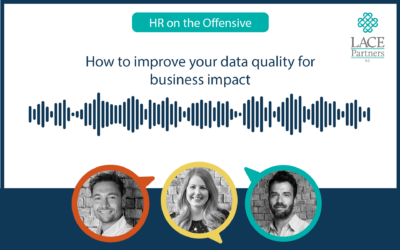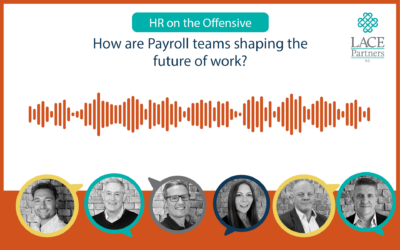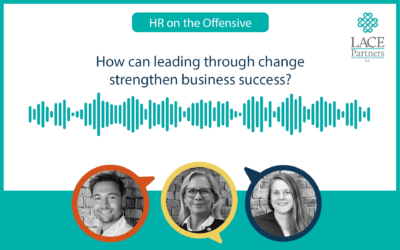In March this year we launched our new People and Workforce Analytics service offering, which has been set up to support the people analytics community in driving forward the value it can deliver to businesses through leveraging people analytics.
To launch the service we also spoke to a wealth of experts in the people analytics space to better understand the market. We then created a whitepaper (which you can download here) that identified seven. Over the coming months we’ll be exploring those themes but today we wanted to reflect on an event we launched with people analytics specialists at the beginning of March (which some of our team also discussed, as well as the whitepaper, in a podcast here) to kick off a new community we have. This community will regularly come together to network and discuss the latest critical thinking in the people analytics space and if you are a people analytics specialist, fill in the form at the end of today’s blog and we’d be happy to consider you for the next invitation-only meeting we have.
Don’t get bogged down in reporting
When we debated about the differences between insights and just “reporting for reporting’s sake”, a clear commonality existed amongst most of the attendees in our community; the key is to focus on what truly adds value. How can the People Analytics Teams ensure that they are only spending their time on things that are truly adding value? How can you minimise reporting so that you avoid sending reports to those that either don’t read it, or don’t make decisions based on the information it contains?
One of the key challenges discussed was around better managing stakeholders, helping to educate and broaden their understanding of analytics, and also to focus on the priorities that will provide the most value to the business. From the experience of the group this takes time and should not be underestimated. However, by improving stakeholder understanding and spending the time helping them to prioritise, a general consensus amongst our community was that it was seen as worth the investment of time and effort.
Data literacy: does HR really understand business challenges?
There was a discussion in the community that a perception of a lack of understanding of how HRBPs interpret data gathered from the People Analytics (PA) Team, which has in some instances that we heard, eventually lead to HRBPs often being bypassed where the PA Team then contacts business units directly (or in some cases not at all).
Where organisations set out skills capability frameworks to understand and assess the level of data literacy amongst the HR function, often data literacy is graded as either low on the scale, or it isn’t even tested at all from the start of the recruitment process. If there isn’t the drive from the business to look to understand the capability of new talent entering the workforce, and their ability to effectively interpret data and utilise it to make evidence-based decision making, then there will always be a challenge when it comes to making strategic people decisions using people analytics at its core.
Does the need therefore exist that culturally more businesses – and leaders from the C-suite and HR/Talent – must change mindsets by setting expectations within businesses that key requirements of future talent must be that they have a higher competency of data literacy? Making data skills and literacy a core competency of your HR team is shown to drive value. It is time to invest in better skills and knowledge in this area. This can be challenging because for many leaders in HR their skillset and the position they have risen to within their business has been because of their knowledge and ability in other aspects in HR, rather than having a particular speciality in their greater data literacy.
Cost of technology as a prohibitor
Making technology decisions to support the development of people analytics is a fundamental business choice. From experience the forum indicated that the cost of people analytics technology was high, and could be a difficult sell to C-suite decision makers. The price of this technology for many companies appears prohibitive. By doing a review of the landscape of analytics technology and building a value case you can prove that value can be delivered within your company and that the true cost of replicating complex technical builds internally may outweigh licencing costs considerably.
Who has responsibility for the People Analytics Function?
This was a fascinating discussion, not least because where the reporting lines exist varied across the different businesses we spoke to on the evening (with variation of one team sitting outside of HR, one reporting directly to the CPO and others sitting at different junctures within the HR team), but also when we spoke to respondents of our whitepaper. Where should PWA sit? For some organisations it is within central Business Intelligence (BI) Team, others it is within the HR function and in some instances, there are designated specialists who report in to specific business units. But what delivers the greatest value to a business?
Should the PA Team report into the Chief People Officer (CPO)? In the room on the night the consensus was that it probably should, but of those that we spoke to, only one company operated under that model.
Due to HR in most instances not having a significant data literacy and broader capability this function often reports into other areas. There is value in this reporting into the CPO so that the appropriate decisions and focus can be made. A real focus on data literacy and capability needs to be made for all levels of HR. The forum agreed that there must be an understanding of the characteristics of people data compared to other business data sets – that is critical. It cannot always be analysed or interpreted in the same way – major consideration if PWA sits outside the function. Is there an argument for PWA to sit in or, at the very least collaborate with. the area of the business which is most analytically mature?
How much value do predictive attrition models have?
The forum discussion then moved to a debate around the value of predictive attrition models, with the consensus being that they are popular but have their limitations:
- Some members would like to develop them to include particular work events (e.g. project funding turned down) which is tricky to record / map
- Some members also felt that human element outside work was ignored as huge factor and most ignore the external labour market and focus on demographic attributes of leavers in the organisation.
Overall this was a great initial debate and discussion to kick off our first ever PWA community and we’ll be running quarterly events to bring together specialists in the PA space to discuss and debate the latest developments in an ever-growing and expanding function across businesses of all sectors, shapes and sizes.
Interested in finding out more or want to talk to one of our teams about your approach to people and workforce analytics? Fill out the form below and we’ll be in touch.






